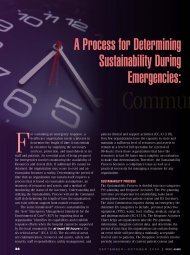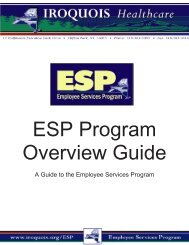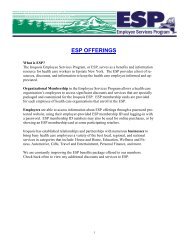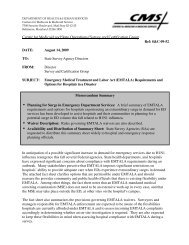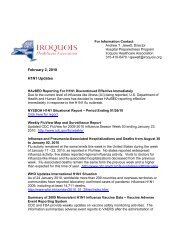NYS Public Health Legal Manual: A Guide for Judges, Attorneys ...
NYS Public Health Legal Manual: A Guide for Judges, Attorneys ...
NYS Public Health Legal Manual: A Guide for Judges, Attorneys ...
Create successful ePaper yourself
Turn your PDF publications into a flip-book with our unique Google optimized e-Paper software.
NEW YORK STATE PUBLIC HEALTH LEGAL MANUAL § 1.126<br />
in court. As long as a statute does not specifically <strong>for</strong>eclose or otherwise<br />
control the use of remote appearances, the courts “may fashion<br />
necessary procedures consistent with constitutional, statutory and<br />
decisional law” to permit remote appearances. People v. Wrotten, 14<br />
N.Y.3d 33, 37-38 (2009) [upholding video trial appearance of witness<br />
in a criminal case who was too ill to travel to New York from<br />
Cali<strong>for</strong>nia, notwithstanding the existence in the CPL of statutes<br />
authorizing video appearances <strong>for</strong> vulnerable child witnesses and<br />
criminal defendants and no statutes addressing video appearances<br />
<strong>for</strong> other witnesses].<br />
Remote appearances in criminal cases do not violate the Confrontation<br />
Clause. United States Constitution, Sixth Amendment; New<br />
York Constitution, Article I, section 6 [“In any trial in any court<br />
whatever the party accused shall be allowed to appear and defend in<br />
person and with counsel as in civil actions and shall be in<strong>for</strong>med of<br />
the nature and cause of the accusation and be confronted with the<br />
witnesses against him or her.”]. Courts have permitted video appearances<br />
where a fact-specific analysis of a particular case shows that a<br />
denial of “physical, face-to-face confrontation” is “necessary to further<br />
an important public policy” and “the reliability of the testimony<br />
is otherwise assured.” People v. Wrotten, supra, 14 N.Y.3d at 39,<br />
quoting Maryland v. Craig, 497 U.S. 836, 850 (1990). The Court of<br />
Appeals in Wrotten upheld a live two-way video appearance by a<br />
witness as “reliable”—because it preserved all the other elements of<br />
the confrontation right, including testimony under oath, opportunity<br />
<strong>for</strong> contemporaneous cross-examination, and the opportunity <strong>for</strong> the<br />
judge, jury and defendant to view the witness’s demeanor. Id. And<br />
the public policy requirement was satisfied notwithstanding that the<br />
public policy was not codified in statute. Id. at 39. The Court of<br />
Appeals concluded: “We agree that the public policy of justly<br />
resolving criminal cases while at the same time protecting the wellbeing<br />
of a witness can require live two-way video testimony in the<br />
rare case where a key witness cannot physically travel to court in<br />
New York and where, as here, defendant’s confrontation rights have<br />
been minimally impaired.” Id. at 40.<br />
71




